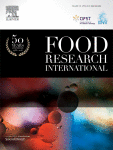Ver ítem
- xmlui.general.dspace_homeCentros Regionales y EEAsCentro Regional Mendoza - San JuanEEA MendozaArtículos científicosxmlui.ArtifactBrowser.ItemViewer.trail
- Inicio
- Centros Regionales y EEAs
- Centro Regional Mendoza - San Juan
- EEA Mendoza
- Artículos científicos
- Ver ítem
Impact of phenolic and polysaccharidic composition on commercial value of Argentinean Malbec and Cabernet Sauvignon wines
Resumen
Knowledge of the chemical composition of wine and its association with the commercial value constitutes an objective tool to assess quality and can be used as a marketing strategy. Phenolic compounds are very important quality parameters of wines because of their impact on color, taste and health properties, and together with polysaccharides contribute to the chemical stability and sensory perception of the products. In this context, the major aims of the
[ver mas...]
Knowledge of the chemical composition of wine and its association with the commercial value constitutes an objective tool to assess quality and can be used as a marketing strategy. Phenolic compounds are very important quality parameters of wines because of their impact on color, taste and health properties, and together with polysaccharides contribute to the chemical stability and sensory perception of the products. In this context, the major aims of the present study were to describe the phenolic and polysaccharidic composition of Argentinean Malbec and Cabernet Sauvignon wines of different price segments, and assessing their impact on the commercial value. Thirty wines representative of three retail price segments (US$ 5–7, 18–20, and > 40) were evaluated. In general, there was a trend towards greater concentration of these compounds with increasing the commercial value of wines. Particularly, it was found that general phenolic composition, color-related compounds, main flavonoid groups and polysaccharides appear as relevant variables differing among segments and showing some differences between varieties. Additionally, the sensory wine description was in good agreement with the analytical results. The wines of greater commercial value, with the best visual and gustatory scores, coincided with higher levels of the phenolic parameters determined. This study provides an interesting insight, no reported so far, on the impact of phenolic and polysaccharidic composition in the final quality of the products and therefore in its market value.
[Cerrar]

Autor
Fanzone, Martín Leandro;
Peña Neira, Alvaro;
Gil, Mariona;
Jofre, Viviana Patricia;
Assof, Mariela Vanesa;
Zamora, Fernando;
Fuente
Food Research International 45 (1) : 402-414 (January 2012)
Fecha
2012-01
Editorial
Elsevier
ISSN
0963-9969
1873-7145
1873-7145
Formato
pdf
Tipo de documento
artículo
Palabras Claves
Derechos de acceso
Restringido
 Excepto donde se diga explicitamente, este item se publica bajo la siguiente descripción: Creative Commons Attribution-NonCommercial-ShareAlike 2.5 Unported (CC BY-NC-SA 2.5)
Excepto donde se diga explicitamente, este item se publica bajo la siguiente descripción: Creative Commons Attribution-NonCommercial-ShareAlike 2.5 Unported (CC BY-NC-SA 2.5)

